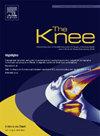The impact of high-heel shoes on knee joint space width in healthy young females: A real-time ultrasound study
IF 1.6
4区 医学
Q3 ORTHOPEDICS
引用次数: 0
Abstract
Background
Wearing high heel shoes is thought to increase the risk of knee osteoarthritis in females by altering knee joint alignment and increasing muscle activation. However, direct measurements of knee joint space width using ultrasound have been limited. This study aimed to investigate the effects of 8-cm high-heel shoes on knee joint articular space in healthy young females during standing.
Methods
A cross-sectional study was conducted with 30 healthy females (age 22 ± 1.3 years). Participants’ knee medial, lateral and patellofemoral joint space width were measured using an ultrasound imaging device in both barefoot and high-heel shoes conditions. A general linear model was used to compare the impact of high-heel shoes on knee joint articular space with adjusted covariates of demographic and lower limb physical measurement data.
Results
Significant reductions in lateral joint space width were observed in both the dominant and non-dominant knees when wearing high-heel shoes compared with barefoot (mean difference: dominant side = 1.63 ± 3.91 mm, non-dominant side = 2.34 ± 2.65 mm, P = 0.008). No significant changes were detected in medial and patellofemoral joint space width.
Conclusion
Wearing 8-cm high-heel shoes significantly reduces the lateral joint space width of the knee in healthy young females during standing, suggesting increased lateral knee joint stress. The current study underscores the importance of including standing as a test component when measuring joint space changes in future studies and clinical practice to comprehensively evaluate the effects of high-heel usage on knee joint biomechanics.
高跟鞋对健康年轻女性膝关节间隙宽度的影响:一项实时超声研究
研究背景穿高跟鞋被认为会通过改变膝关节的排列和增加肌肉的激活来增加女性患膝骨关节炎的风险。然而,使用超声波直接测量膝关节间隙宽度是有限的。本研究旨在探讨8厘米高跟鞋对健康年轻女性站立时膝关节关节间隙的影响。方法对30例健康女性(年龄22±1.3岁)进行横断面研究。在赤脚和穿高跟鞋的情况下,研究人员使用超声成像设备测量了参与者的膝关节内侧、外侧和髌骨关节间隙宽度。采用一般线性模型比较高跟鞋对膝关节关节间隙的影响与调整后的人口统计学协变量和下肢物理测量数据。结果与赤脚相比,穿高跟鞋时主、非主双膝外侧关节间隙宽度均显著减小(平均差值:主侧= 1.63±3.91 mm,非主侧= 2.34±2.65 mm, P = 0.008)。内侧和髌股关节间隙宽度未见明显变化。结论健康年轻女性站立时穿8 cm高跟鞋可显著降低膝关节外侧关节间隙宽度,提示膝关节外侧关节应力增加。目前的研究强调了在未来的研究和临床实践中,在测量关节间隙变化时,将站立作为一个测试组件来全面评估高跟鞋使用对膝关节生物力学的影响的重要性。
本文章由计算机程序翻译,如有差异,请以英文原文为准。
求助全文
约1分钟内获得全文
求助全文
来源期刊

Knee
医学-外科
CiteScore
3.80
自引率
5.30%
发文量
171
审稿时长
6 months
期刊介绍:
The Knee is an international journal publishing studies on the clinical treatment and fundamental biomechanical characteristics of this joint. The aim of the journal is to provide a vehicle relevant to surgeons, biomedical engineers, imaging specialists, materials scientists, rehabilitation personnel and all those with an interest in the knee.
The topics covered include, but are not limited to:
• Anatomy, physiology, morphology and biochemistry;
• Biomechanical studies;
• Advances in the development of prosthetic, orthotic and augmentation devices;
• Imaging and diagnostic techniques;
• Pathology;
• Trauma;
• Surgery;
• Rehabilitation.
 求助内容:
求助内容: 应助结果提醒方式:
应助结果提醒方式:


